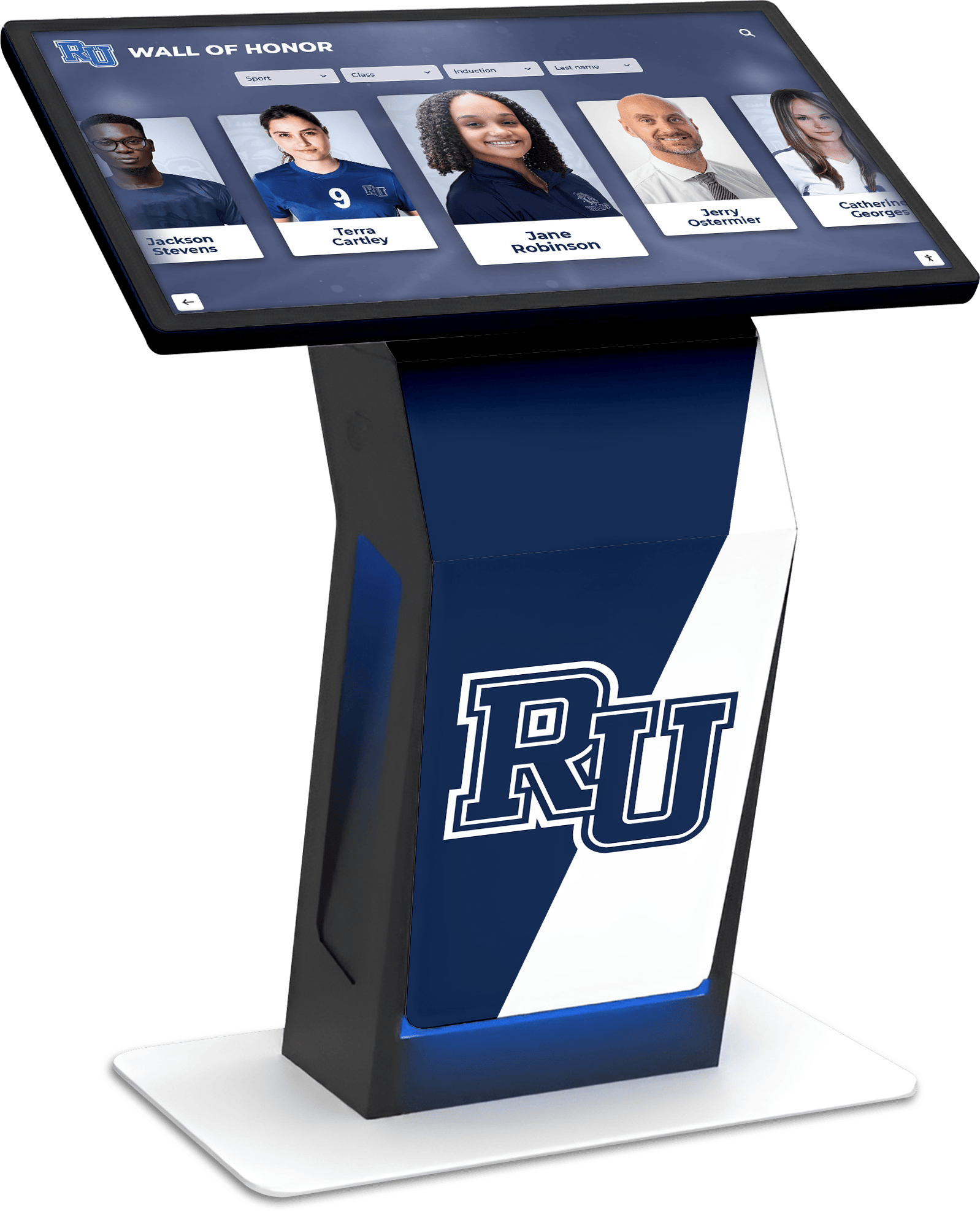Introduction: The Critical Role of Computing Hardware in Touchscreen Kiosk Success
The computer module powering your touchscreen kiosk directly determines system performance, reliability, user experience quality, and long-term maintenance costs. While displays attract attention and touchscreens enable interaction, the computing hardware behind the scenes processes content, manages interactions, and ensures smooth operation throughout the system’s operational life.
This comprehensive guide examines every aspect of computer module selection for touchscreen kiosks, from system-on-chip displays and dedicated media players through mini PCs and full-sized computers. Whether implementing a single interactive recognition display or a multi-location kiosk network, understanding computing hardware options ensures your investment delivers exceptional performance and reliability for years.
The global interactive kiosk hardware market continues expanding rapidly, driven by increasing demand for self-service solutions across education, healthcare, retail, and corporate environments. Organizations making informed computer module selections position themselves for success through reliable operation, simplified maintenance, and superior user experiences that justify their technology investments.
Understanding Computer Module Options for Touchscreen Kiosks
Computer modules for touchscreen kiosks fall into several distinct categories, each offering different capabilities, price points, and use case alignments. Understanding these options enables informed selections matching specific application requirements and organizational capabilities.
System-on-Chip (SoC) Integrated Displays
Modern commercial displays increasingly include integrated computing capabilities built directly into the display hardware, eliminating the need for separate computer modules.
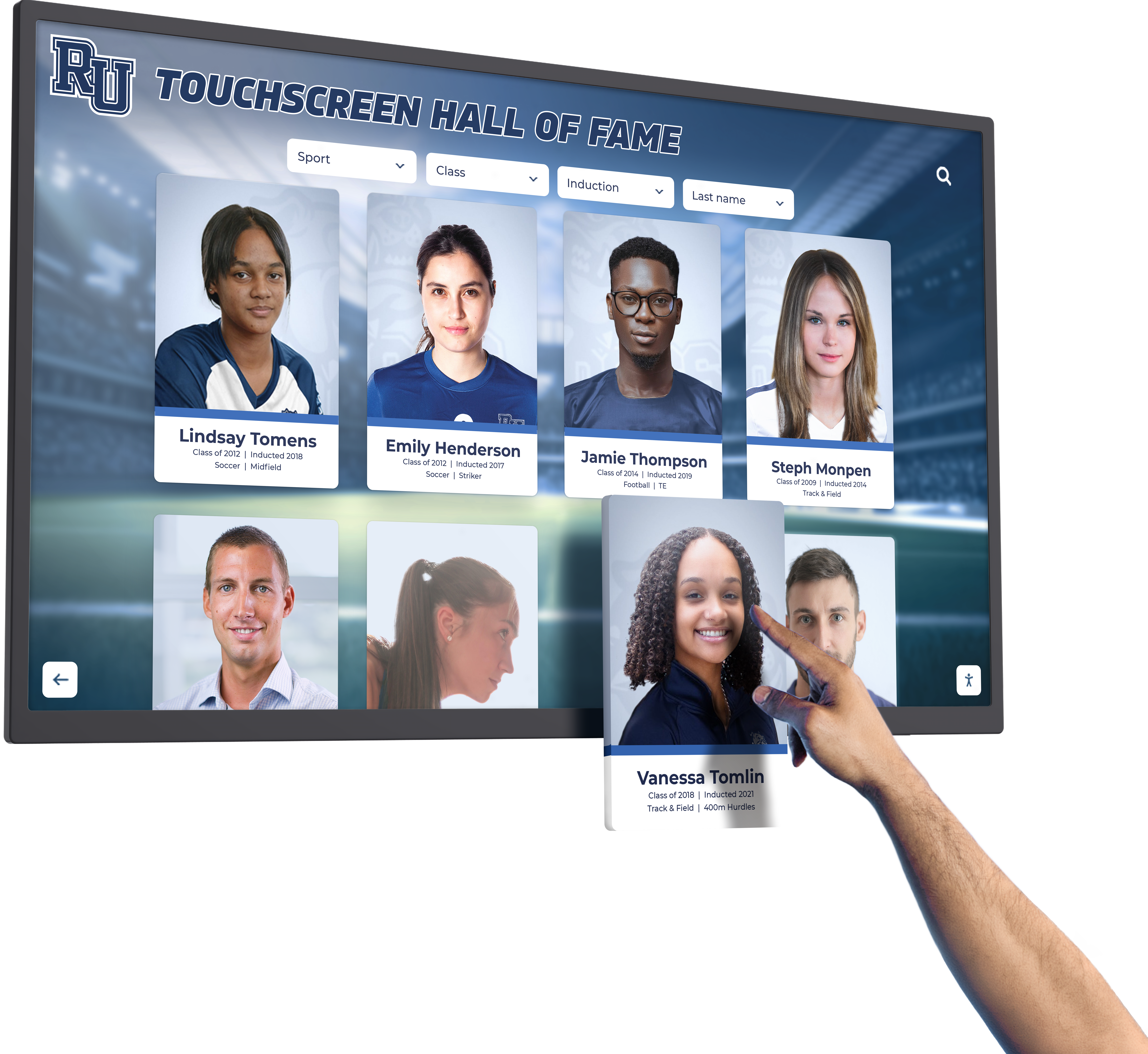
How SoC Displays Work:
System-on-chip displays incorporate ARM or x86 processors, memory, storage, and operating systems directly into display hardware. These integrated systems run kiosk software natively without requiring external computers, simplifying installations through reduced components and cabling.
Advantages of SoC Solutions:
- Simplified Installation: Fewer components mean less complexity in setup and configuration
- Reduced Cabling: Power and network connection are typically all that’s required
- Lower Component Count: Fewer separate devices reduce potential failure points
- Streamlined Management: Single integrated system simplifies remote monitoring
- Cost Efficiency: Eliminates separate computer purchase in many implementations
- Compact Form Factor: No external computer housing or mounting requirements
Considerations and Limitations:
- Limited Processing Power: Integrated processors typically offer less performance than dedicated computers
- Restricted Upgrade Path: Cannot upgrade computing components without replacing entire display
- Platform Constraints: Often locked to specific operating systems or software frameworks
- Content Complexity Limits: May struggle with video-heavy or highly interactive content
- Longevity Concerns: Computer obsolescence may occur before display reaches end-of-life
Ideal Applications for SoC Displays:
System-on-chip solutions work well for straightforward content display applications, basic interactive menus, and installations where simplicity trumps maximum performance. However, organizations implementing sophisticated interactive experiences—like comprehensive digital hall of fame displays—typically require more powerful dedicated computing solutions.
Dedicated Media Players and Streaming Devices
Purpose-built media players represent a middle ground between integrated SoC displays and full-featured computers, offering better performance than SoC solutions while maintaining compact form factors and simplified management.
Popular Media Player Platforms:
- BrightSign Players: Professional digital signage players with robust hardware and extensive format support
- Raspberry Pi (Commercial Implementations): ARM-based single-board computers customized for kiosk deployments
- Amazon Fire TV Cube: Consumer devices adapted for commercial applications
- Android Media Players: Dedicated boxes running Android operating systems optimized for content display
Media Player Advantages:
Dedicated media players excel in reliability through purpose-built designs optimized for continuous operation. Most feature fanless construction eliminating moving parts that eventually fail, along with low power consumption (typically 5-25 watts) reducing electrical costs and heat generation. Small form factors enable concealed mounting behind displays or within kiosk enclosures, while specialized firmware reduces security vulnerabilities compared to general-purpose computers.
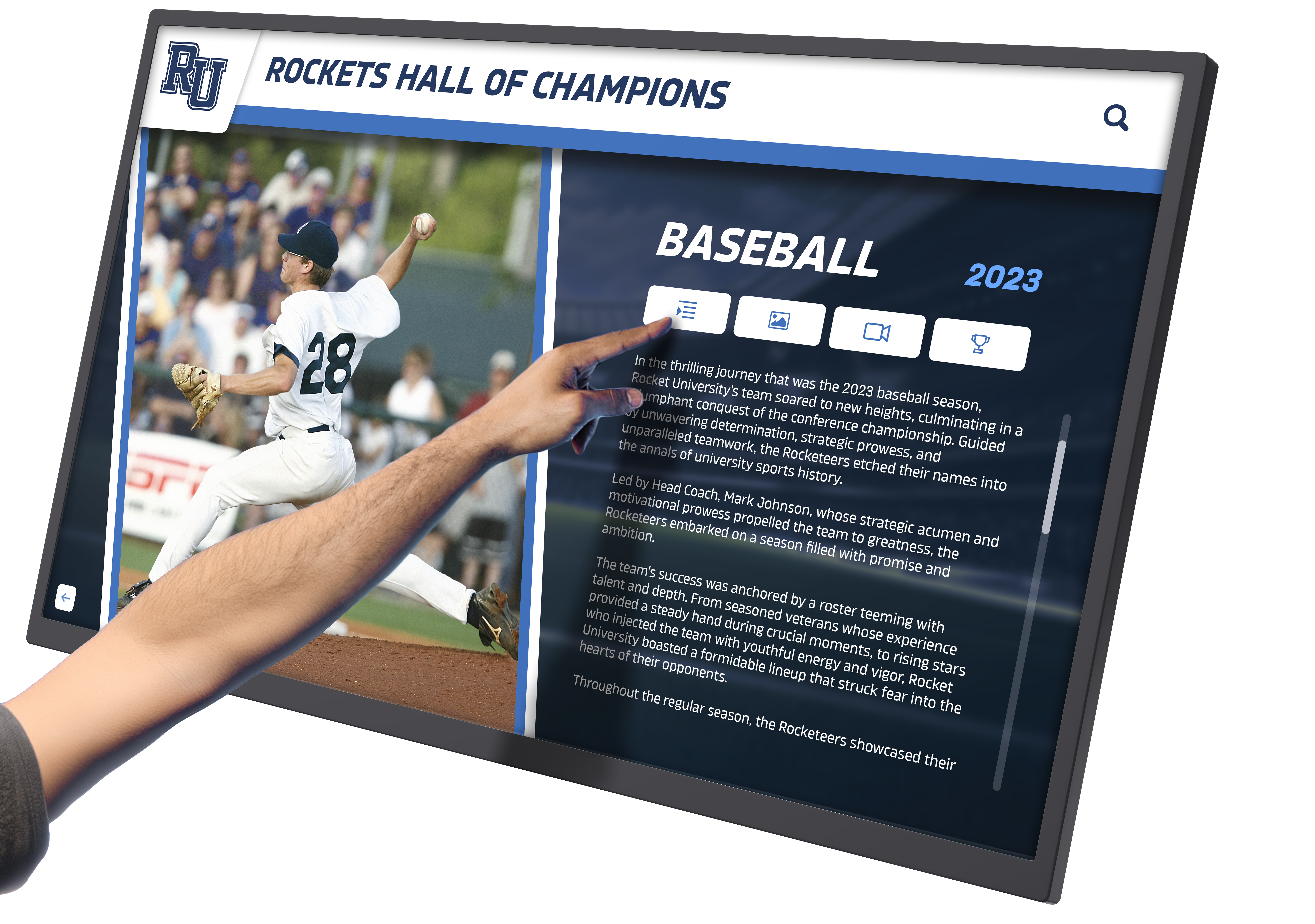
Media Player Limitations:
Processing power constraints limit complex interactive applications and high-resolution video playback. Platform restrictions may prevent running certain software applications not designed for media player operating systems. Storage limitations affect local content libraries, particularly for installations featuring extensive image or video collections. Peripheral connectivity may be limited compared to full computers, restricting options for sensors, cameras, or specialized input devices.
Recommended Specifications for Media Players:
When selecting dedicated media players for touchscreen kiosk applications, prioritize these minimum specifications:
- Processor: Quad-core ARM (Raspberry Pi 4/5) or x86 equivalent
- RAM: 4GB minimum, 8GB recommended for multimedia content
- Storage: 64GB minimum, 128GB+ for extensive content libraries
- Network: Gigabit Ethernet (preferred) or WiFi 5/6
- Video Output: HDMI 2.0 or DisplayPort supporting 4K resolution
- Operating System: Linux-based systems or commercial Android builds
Mini PCs: The Sweet Spot for Interactive Touchscreen Kiosks
Mini PCs have emerged as the optimal computer module choice for most interactive touchscreen kiosk installations, offering full computer capabilities in compact, energy-efficient form factors specifically suited to kiosk environments.
Understanding Mini PC Architecture
Mini PCs pack complete computer functionality—processors, memory, storage, connectivity—into form factors measuring 4-8 inches square and 1-3 inches tall. Despite small sizes, modern mini PCs deliver performance rivaling full-sized desktop computers while consuming fraction of the power and generating minimal heat.
Leading Mini PC Platforms:
Intel NUC (Next Unit of Computing):
- Industry-leading mini PC platform with extensive model range
- Available from budget (Celeron) to high-performance (Core i7/i9) configurations
- Excellent Linux and Windows compatibility
- Strong commercial support and long product lifecycles
- Robust build quality appropriate for 24/7 operation
HP EliteDesk Mini:
- Enterprise-grade reliability with comprehensive warranties
- Enhanced security features for institutional environments
- Tool-free serviceability simplifying maintenance
- Energy Star certified for efficiency
- Managed IT integration for corporate deployments
Lenovo ThinkCentre Tiny:
- Business-class construction and reliability
- Excellent performance-per-watt efficiency
- Extensive peripheral connectivity options
- VESA mounting brackets for display integration
- Strong driver support across operating systems
Dell OptiPlex Micro:
- Commercial-grade components and extended warranties
- Flexible configuration options matching varied needs
- Small form factor (7.2" x 7.2" x 1.4")
- Long product availability supporting fleet consistency
- Enterprise management tools for IT departments
Mini PC Performance Specifications for Kiosk Applications
Proper mini PC specification ensures smooth interactive experiences without over-provisioning expensive components unnecessary for kiosk applications.
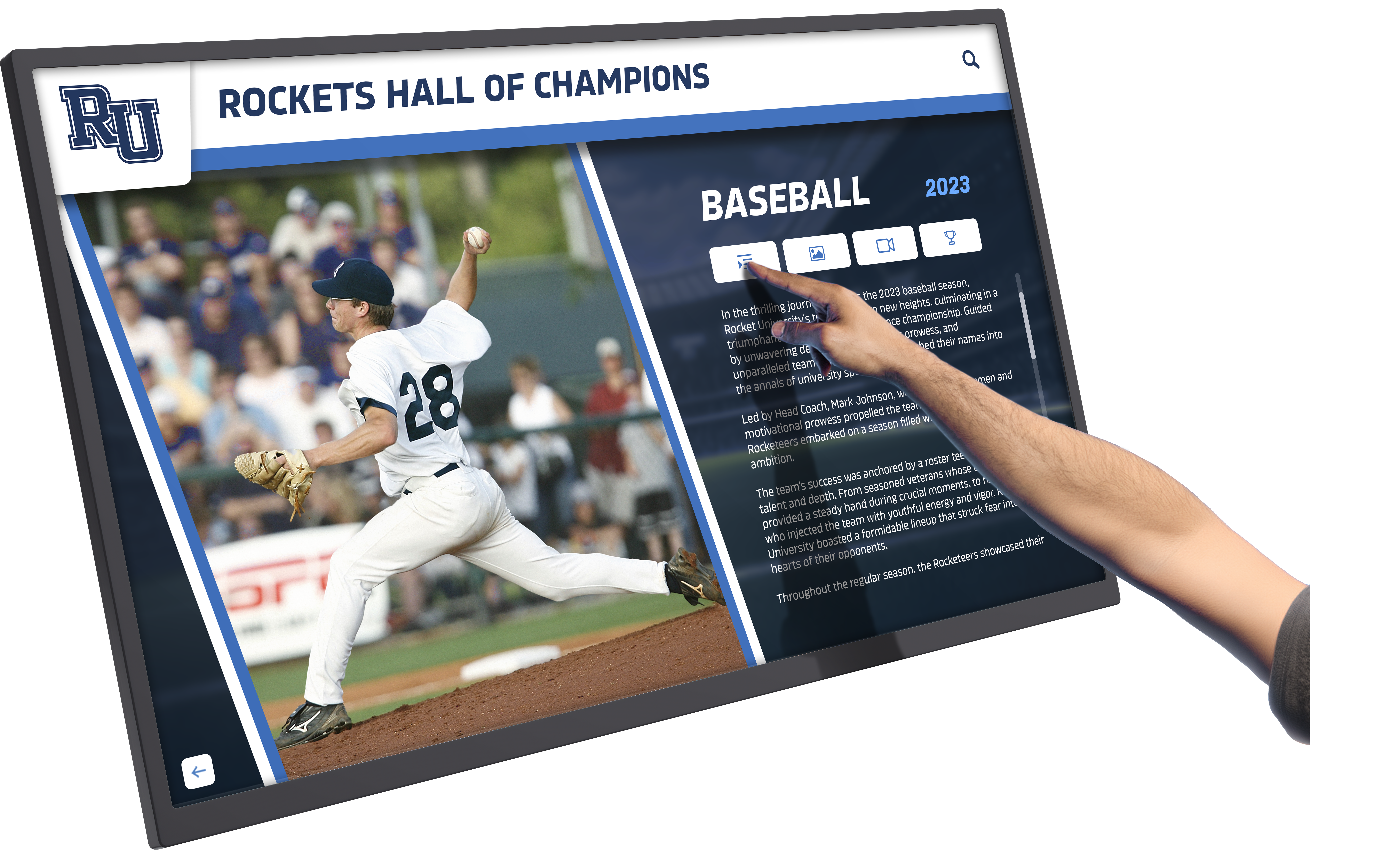
Processor Requirements:
The CPU determines overall system responsiveness and ability to handle complex content. For touchscreen kiosk applications:
Entry-Level (Basic Content Display): Intel Celeron N-series or AMD Athlon Silver provide adequate performance for simple presentations and basic interactivity, suitable for information kiosks with minimal user interaction demands.
Recommended Standard (Interactive Displays): Intel Core i5 (11th gen or newer) or AMD Ryzen 5 deliver excellent balance of performance and efficiency for typical kiosk applications, handling smooth touch interactions, multimedia content, and moderate complexity without strain.
High-Performance (Complex Applications): Intel Core i7/i9 or AMD Ryzen 7 provide headroom for demanding applications featuring extensive video content, complex animations, simultaneous multi-user interaction, or resource-intensive custom software.
Memory (RAM) Specifications:
RAM capacity directly impacts multitasking capability and content loading speeds:
- 8GB RAM: Minimum for Windows-based kiosks running interactive applications
- 16GB RAM: Recommended for content-rich displays with extensive media libraries
- 32GB RAM: Beneficial for video walls or applications with significant background processing
Modern DDR4 or DDR5 memory provides excellent performance for kiosk applications. Ensure selected mini PCs offer upgradeable memory slots for future expansion if requirements grow.
Storage Configuration:
Storage performance affects boot times, content loading speeds, and overall system responsiveness. Solid-state drives (SSDs) are essential for kiosk applications:
- 256GB SSD: Adequate for basic installations with limited local content
- 512GB SSD: Recommended for standard kiosk deployments with moderate media libraries
- 1TB+ SSD: Beneficial for extensive offline content libraries or video-heavy applications
NVMe SSDs offer superior performance compared to SATA SSDs, dramatically reducing boot times and content loading delays. The performance difference justifies modest cost premiums for professional installations.
Operating System Considerations for Mini PCs
Operating system selection significantly impacts software compatibility, security posture, management complexity, and total cost of ownership.
Windows Professional/Enterprise:
Microsoft Windows remains the dominant platform for commercial kiosk applications, offering:
- Broad software compatibility with virtually all kiosk and digital signage applications
- Familiar interfaces reducing administrator training requirements
- Comprehensive management tools for IT departments through Active Directory and group policies
- Strong hardware driver support across diverse peripheral devices
- Regular security updates and long-term support options
Windows licensing adds per-device costs but delivers value through mature ecosystem and extensive capabilities. Windows 10 IoT Enterprise and Windows 11 provide enhanced kiosk modes and security features specifically designed for public-facing deployments.
Linux Distributions:
Linux-based operating systems provide cost-effective, secure alternatives for kiosk applications:
- Ubuntu LTS (Long-Term Support) releases offer stability with regular security patches
- Debian provides rock-solid reliability for custom kiosk implementations
- Chrome OS Flex brings Google’s cloud-centric platform to standard x86 hardware
- Specialized kiosk distributions like Porteus Kiosk offer turnkey solutions
Linux eliminates licensing costs while delivering excellent security and stability. However, limited software compatibility and smaller support ecosystems require more technical expertise for implementation and troubleshooting.
Recommended Choice:
For most organizations implementing interactive touchscreen kiosks, Windows Professional provides optimal balance of capability, compatibility, and support. The licensing cost proves worthwhile through simplified software deployment, extensive hardware compatibility, and abundant troubleshooting resources.
Organizations with strong Linux expertise or using web-based kiosk software may find Linux distributions perfectly adequate while reducing licensing expenses.
Power Consumption and Thermal Management
Mini PCs’ efficiency advantages extend beyond compact form factors to electrical consumption and heat generation—critical considerations for installations operating 12-16 hours daily.
Typical Mini PC Power Consumption:
- Idle: 5-15 watts depending on configuration
- Typical Operation: 25-45 watts for standard interactive applications
- Maximum Load: 45-65 watts during peak processing demands
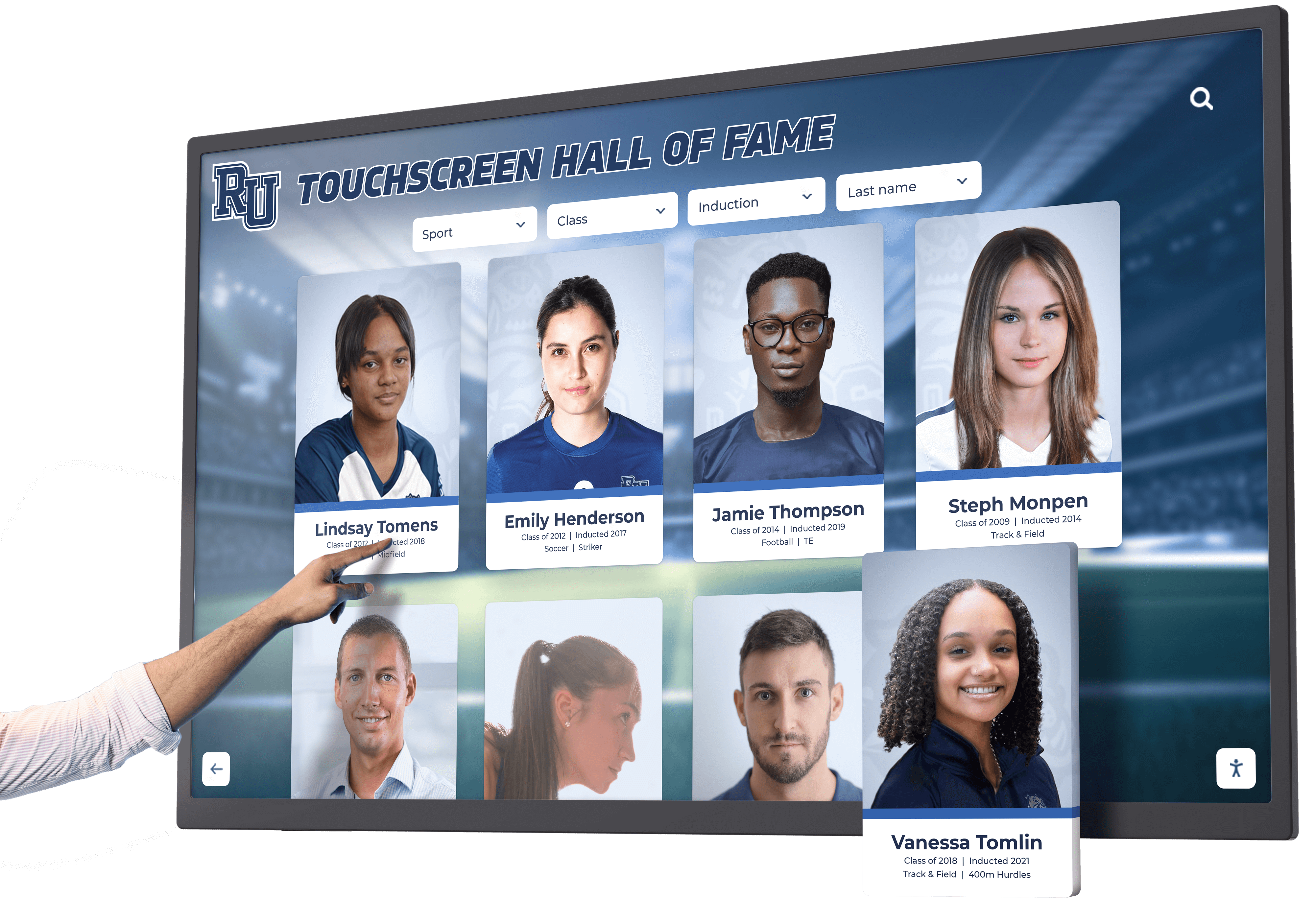
Compare these figures to traditional desktop computers consuming 80-200+ watts, and the annual energy savings become substantial for organizations deploying multiple kiosks.
Annual Operating Cost Example:
Mini PC (average 35W) operating 12 hours daily:
35W × 12 hours × 365 days × $0.13/kWh = $20/year per kiosk
Traditional Desktop (average 150W) same usage:
150W × 12 hours × 365 days × $0.13/kWh = $85/year per kiosk
Annual Savings: $65 per kiosk
10-Kiosk Deployment: $650/year energy savings
Thermal Considerations:
Mini PCs generate significantly less heat than traditional computers, but proper ventilation remains important for reliability and longevity. Ensure installations provide adequate airflow around mini PC enclosures, avoid completely enclosed cabinets without ventilation, position mini PCs away from heat-generating components, and provide clearance for intake and exhaust areas per manufacturer specifications.
Most quality mini PCs include temperature monitoring and thermal throttling, automatically reducing performance to prevent overheating if ventilation becomes restricted. However, proper installation prevents such scenarios from occurring.
Connectivity and Peripheral Integration
Computer modules for touchscreen kiosks must support diverse connectivity requirements, from display outputs and network connections through specialized peripherals and expansion capabilities.
Display Connectivity Standards
Modern mini PCs and media players support multiple video output standards, each offering different capabilities and compatibility profiles.
HDMI (High-Definition Multimedia Interface):
HDMI represents the most common display connection standard, offering broad compatibility across consumer and commercial displays. HDMI 2.0 supports 4K resolution at 60Hz—adequate for virtually all kiosk applications. HDMI 2.1 adds 8K support and higher refresh rates, though few kiosk displays currently require these capabilities. HDMI cables carry both video and audio signals through single connections, simplifying installation.
DisplayPort:
DisplayPort provides technical advantages over HDMI, particularly for professional applications. DisplayPort 1.4 supports 8K resolution and daisy-chaining multiple displays from single outputs. Superior bandwidth enables higher refresh rates at 4K resolutions. DisplayPort adapters enable HDMI connectivity when needed.
USB-C with DisplayPort Alt Mode:
Modern mini PCs increasingly offer USB-C ports supporting DisplayPort video output, enabling single-cable connectivity carrying video, power, and data simultaneously. This simplified connectivity reduces cable management complexity and supports docking station solutions consolidating multiple connections.
Recommendation:
For most touchscreen kiosk installations, HDMI provides adequate capabilities with maximum compatibility. Organizations planning 8K displays or multi-display configurations should prioritize DisplayPort connectivity.
Network Connectivity Requirements
Reliable network connectivity enables remote management, content updates, and system monitoring—critical capabilities for multi-site kiosk deployments.
Wired Ethernet (Strongly Recommended):
Gigabit Ethernet provides optimal connectivity for kiosk applications through consistent performance unaffected by interference, superior security compared to wireless alternatives, simplified troubleshooting when issues occur, and no bandwidth sharing with other devices. Professional kiosk installations should always include Ethernet infrastructure during construction or renovation planning.
WiFi Connectivity:
While less ideal than wired connections, WiFi 5 (802.11ac) or WiFi 6 (802.11ax) provide acceptable performance when:
- Wired infrastructure cannot be retrofitted cost-effectively
- Displays require flexibility for repositioning
- Strong, consistent wireless signals (-67 dBm or better) are verified
- Proper network segmentation and security protocols are implemented
Organizations relying on WiFi should specify mini PCs with high-quality wireless adapters and conduct thorough signal strength testing before finalizing kiosk placements.
USB and Peripheral Support
Touchscreen kiosks often require peripheral device connectivity beyond basic display and network connections.
Common Peripheral Requirements:
- Touchscreen Controllers: USB connections carrying touch data from screen to computer
- Webcams: Video capture for testimonials, virtual tours, or monitoring
- Speakers/Audio Systems: Enhanced audio beyond display’s integrated speakers
- Card Readers: Badge access or payment processing (where applicable)
- Sensors: Motion detection, proximity sensing, or environmental monitoring
- Printers: Receipt or ticket printing for self-service applications
Mini PCs should provide sufficient USB ports (minimum 4, ideally 6+) supporting these peripherals without requiring external hubs that introduce complexity and potential failure points. USB 3.0 or newer ensures adequate bandwidth for multiple simultaneous devices.
Comparing Full-Sized Computers vs. Mini PCs vs. Media Players
Understanding trade-offs between different computer module categories helps organizations select optimal solutions for their specific kiosk requirements and constraints.
Performance Comparison Matrix
Different computer module types deliver varying performance levels appropriate for different application complexities:
| Computer Module Type | Processing Power | Graphics Capability | Storage Capacity | Expansion Options | Typical Cost Range |
|---|---|---|---|---|---|
| Media Players | ⭐⭐ Basic | ⭐⭐ Limited | ⭐⭐ Constrained | ⭐ Minimal | $50-$300 |
| System-on-Chip | ⭐⭐ Basic-Moderate | ⭐⭐ Adequate | ⭐⭐ Moderate | ⭐ None | Included in Display |
| Mini PCs | ⭐⭐⭐⭐ Excellent | ⭐⭐⭐⭐ Very Good | ⭐⭐⭐⭐ Flexible | ⭐⭐⭐ Good | $400-$1,200 |
| Full-Sized PCs | ⭐⭐⭐⭐⭐ Maximum | ⭐⭐⭐⭐⭐ Exceptional | ⭐⭐⭐⭐⭐ Extensive | ⭐⭐⭐⭐⭐ Unlimited | $600-$2,000+ |
Use Case Alignment
Different kiosk applications align naturally with specific computer module categories based on complexity and performance demands.
Media Players Excel For:
- Simple information displays with static or slowly updating content
- Basic interactive menus with limited navigation depth
- Wayfinding applications with pre-rendered maps
- Simple digital signage with scheduled content rotation
Mini PCs Recommended For:
- Interactive recognition displays showcasing achievements and histories
- Touchscreen hall of fame installations with searchable databases
- Digital record boards featuring multimedia content
- Educational kiosks with rich media integration
- Museum exhibits requiring responsive interactivity
Full-Sized PCs Justified For:
- Video walls requiring multiple synchronized displays
- High-resolution video editing or generation stations
- Applications requiring specialized expansion cards
- Installations with exceptional performance demands
For most interactive touchscreen kiosk applications, mini PCs deliver optimal balance of performance, cost, reliability, and physical integration—making them the recommended choice for organizations implementing professional recognition displays.
Implementation Best Practices for Computer Modules in Kiosk Deployments
Proper implementation ensures computer modules deliver reliable performance throughout expected operational lifespans of 5-7 years.
Physical Mounting and Installation
Computer module placement significantly impacts accessibility, thermal performance, and aesthetics.
Recommended Mounting Locations:
- Behind Display (Most Common): VESA mounting brackets attach mini PCs directly to display backs, concealing hardware while maintaining easy access for maintenance
- Within Kiosk Enclosure: Custom enclosures incorporate dedicated computer compartments with ventilation and access panels
- Under Counter/Desk: Furniture-integrated installations place computers in accessible yet hidden locations
- Wall-Mounted Separately: Independent mounting near displays works when integrated mounting isn’t feasible
Critical Installation Considerations:
Ensure adequate ventilation with 2-3 inches clearance on all sides for airflow. Avoid completely enclosed spaces without ventilation. Position computers to enable natural convection (hot air rises). Secure mounting prevents theft and accidental disconnection. Use proper mounting hardware rated for equipment weight. Consider future access requirements for maintenance and upgrades. Cable management should be clean and professional, with adequate service loops allowing component removal without complete disconnection.
Security Configuration Best Practices
Public-facing kiosk computers require robust security configurations protecting both systems and user data.
Operating System Hardening:
Configure Windows in kiosk mode restricting user access to only approved applications. Disable unnecessary services reducing attack surface and resource consumption. Enable automatic security updates ensuring timely vulnerability patches. Implement strong local administrator passwords stored securely. Configure BIOS/UEFI passwords preventing unauthorized boot device changes.
Network Security:
Segment kiosk networks from sensitive internal systems through VLAN configuration. Enable firewall rules restricting traffic to only necessary services. Disable unused network protocols and services. Implement network-level monitoring detecting anomalous behavior. Consider VPN connectivity for remote management over public networks.
Application Security:
Configure application-level kiosk modes preventing user escape. Implement automatic session timeouts returning displays to home screens. Clear all temporary files and cached data between user sessions. Disable browser features like downloads, file system access, and settings changes. Configure content security policies restricting external resource loading.
Maintenance and Monitoring Procedures
Proactive maintenance extends computer module lifespans while preventing unexpected failures.
Monthly Maintenance Tasks:
- Verify systems boot properly and applications launch correctly
- Check for and install available security updates
- Review system logs identifying recurring errors or warnings
- Verify adequate free disk space (minimum 20% free recommended)
- Test remote management connectivity and controls
Quarterly Maintenance Tasks:
- Physical inspection of mounting security and cable connections
- Cleaning of air vents and fan intakes preventing dust accumulation
- Verification of backup and recovery procedures
- Testing of fail-over or redundancy mechanisms if implemented
- Review of performance metrics identifying degradation trends
Annual Maintenance Tasks:
- Comprehensive hardware inspection and cleaning
- BIOS/firmware updates when applicable
- Full system backups before any significant changes
- Review of capacity planning and performance adequacy
- Planning for eventual hardware refresh cycles
Organizations implementing digital recognition displays should establish documented maintenance schedules and assign clear responsibilities ensuring consistent system care.
Total Cost of Ownership Analysis
Computer module selection must account for complete lifecycle costs beyond initial purchase prices.
Initial Hardware Investment
Hardware costs vary significantly based on computer module category and configuration:
Budget Mini PC Configuration:
- Computer Module: $400-$600 (Intel Core i5, 8GB RAM, 256GB SSD)
- Operating System: $100-$150 (Windows Professional OEM)
- Mounting Hardware: $30-$75 (VESA mount, cable management)
- Initial Setup: $100-$200 (configuration, security hardening)
- Total Initial Cost: $630-$1,025
Recommended Mini PC Configuration:
- Computer Module: $700-$950 (Intel Core i7, 16GB RAM, 512GB SSD)
- Operating System: $100-$150 (Windows Professional OEM)
- Mounting Hardware: $30-$75 (VESA mount, cable management)
- Warranty Extension: $100-$200 (3-5 year on-site service)
- Initial Setup: $150-$300 (configuration, integration, testing)
- Total Initial Cost: $1,080-$1,675
High-Performance Configuration:
- Computer Module: $1,000-$1,400 (Intel Core i9, 32GB RAM, 1TB SSD)
- Operating System: $100-$150 (Windows Professional OEM)
- Mounting Hardware: $50-$100 (premium mounting solutions)
- Warranty Extension: $150-$300 (comprehensive coverage)
- Initial Setup: $200-$400 (complex configuration, optimization)
- Total Initial Cost: $1,500-$2,350
Ongoing Operational Costs
Beyond initial purchase, computer modules incur ongoing expenses throughout operational lifespans:
Annual Operating Costs:
- Electrical Power: $15-$25/year (mini PC at $0.13/kWh)
- Software Licensing: $0-$200/year (varies by platform and applications)
- Maintenance Labor: $100-$400/year (assuming quarterly checks and updates)
- Security Updates: $0-$100/year (potentially included in service contracts)
- Performance Monitoring: $50-$150/year (remote management tools)
Annual Total: $165-$875 depending on configuration and service level requirements.
Replacement Cycles and Planning
Mini PCs typically require replacement every 5-7 years as processing demands increase and hardware reaches end-of-life.
Replacement Triggers:
- Performance inadequacy for current software requirements
- Hardware failures outside of warranty coverage
- Operating system obsolescence ending security updates
- Accumulated maintenance costs approaching replacement value
Organizations should budget approximately 20% of initial computer module cost annually toward eventual replacement, ensuring funds availability when refresh cycles arrive.
Selecting the Right Computer Module for Your Touchscreen Kiosk
Systematic evaluation ensures computer module selections align with specific requirements, budget constraints, and long-term objectives.
Assessment Framework
Step 1: Define Performance Requirements
Catalog your kiosk application’s specific demands:
- Content complexity (static images, video, complex animations)
- Interactive features (search, filtering, multimedia playback)
- Concurrent user support (single vs. multi-user scenarios)
- Content update frequency and method
- Offline operation requirements
Step 2: Identify Environmental Constraints
Consider installation environment factors:
- Available physical space for computer mounting
- Ambient temperature ranges and ventilation
- Network infrastructure (wired vs. wireless)
- Power availability and circuit capacity
- Physical security and theft concerns
Step 3: Evaluate Technical Capabilities
Assess organizational resources:
- IT staff expertise with different platforms
- Existing infrastructure and standards
- Remote management requirements
- Support and service availability
- Training capabilities for administrators
Step 4: Calculate Total Cost of Ownership
Compare complete lifecycle costs:
- Initial hardware and software investment
- Installation and configuration labor
- Ongoing power and maintenance expenses
- Support and warranty coverage
- Expected replacement timeline
Recommended Selections by Application Type
Different kiosk applications naturally align with specific computer module categories:
For Interactive Recognition Displays:
Digital hall of fame installations showcasing achievements, alumni profiles, and organizational history benefit from mini PCs providing:
- Processing power for smooth database searches and filtering
- Storage capacity for extensive multimedia libraries
- Graphics capability for high-resolution images and video
- Expansion flexibility for future feature additions
Recommended Configuration: Intel Core i5 or i7, 16GB RAM, 512GB SSD, Windows Professional
For Simple Information Displays:
Basic kiosks presenting announcements, directories, or schedules can utilize more economical solutions:
- Media players or entry-level mini PCs
- System-on-chip displays for truly simple content
- Lower specifications adequate for limited interactivity
Recommended Configuration: Intel Celeron or Core i3, 8GB RAM, 256GB SSD, Windows or Linux
Conclusion: Investing in Reliable Computing Performance
Computer modules represent the heart of touchscreen kiosk systems, determining user experience quality, operational reliability, and long-term success. While tempting to minimize computer costs through underpowered hardware selections, such short-term savings inevitably cost more through poor user experiences, increased troubleshooting, and premature replacement needs.
Key Selection Principles:
- Prioritize mini PCs for interactive applications requiring responsive performance
- Specify adequate processing power, memory, and storage for content demands
- Choose Windows for maximum software compatibility and support resources
- Invest in quality brands offering extended warranties and support
- Plan for complete lifecycle costs including maintenance and replacement
- Consider future requirements when specifying today’s hardware
Organizations implementing professional interactive displays—whether for athletic achievement recognition, alumni engagement, or donor acknowledgment—find properly specified mini PCs deliver exceptional value through reliable performance, simplified maintenance, and user experiences that justify technology investments.
Solutions like Rocket Alumni Solutions provide guidance on hardware specifications optimized for their interactive recognition software, ensuring computer modules match application demands. This integrated approach to hardware and software selection creates cohesive systems delivering exceptional results.
Ready to implement a touchscreen kiosk with computing hardware specified for lasting performance? Contact Rocket Alumni Solutions to discuss your project requirements and receive expert recommendations on computer modules optimized for your specific application and environment.
